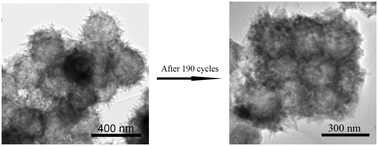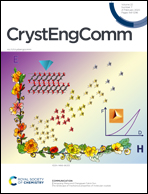Double-shell SnO2@Fe2O3 hollow spheres as a high-performance anode material for lithium-ion batteries
Abstract
Construction of novel electrode materials is an effective way to enhance the electrochemical performance of lithium ion batteries (LIBs). In this work, double-shell SnO2@Fe2O3 hollow spheres are fabricated through a simple template method. It is revealed that the α-Fe2O3 nanorods are heterogeneously assembled on the surfaces of hollow SnO2 spheres. The double-shell SnO2@Fe2O3 hollow spheres, as an anode material for LIBs, demonstrate excellent lithium storage capacity and cycling stability. Their discharge specific capacity decreases to 464 mA h g−1 for the 46th cycle at a current density of 100 mA g−1, and then increases significantly to 1043 mA h g−1 up to the 190th cycle. Compared with SiO2@SnO2 (221 mA h g−1 after 190 cycles) and SnO2 (336 mA h g−1 after 190 cycles) electrodes, the better electrochemical performance of the SnO2@Fe2O3 electrode is ascribed to its hierarchical hollow urchin-like structure, the SnO2@Fe2O3 heterojunctions and the oxygen vacancies in the α-Fe2O3 nanorods. The sea urchin-like heterostructures dramatically inhibit the agglomeration and prevent the volume expansion during the cycling process. This work provides a novel way to construct a promising material with enhanced performance as an anode for LIBs.



 Please wait while we load your content...
Please wait while we load your content...